|
How to Choose an Invertebrate: Part 1 - Janitorial Inverts
Part 1 looks at janitorial invertebrates good at algae control, sand sifting, detritus control, and fish cleaning 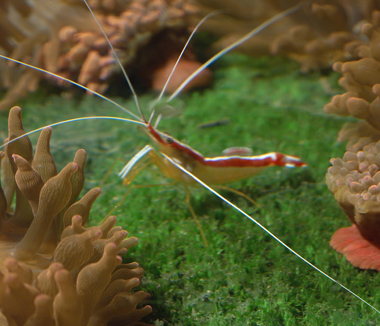
It's strange that we group 95 percent of the animals on Planet Earth into the one very general category called "invertebrates." Maybe it's because we humans are most interested in how we compare to other species? Whatever your opinion about taxonomy, however, when it comes to marine invertebrates for your saltwater aquarium, rest assured, you have many from which to choose.
Some invertebrates are valued for their janitorial skills, like Astraea Snails (Astraea spp.). Others are prized for their beauty, such as Rose Bubble Anemones (Entacmaea quadricolor) and Linckia Starfish (Linckia laevigata). There are exotic looking invertebrates such as the Red Foot Snail (Norrisia norrisii) and the Sexy Shrimp (Thor amboinensis). A few, like the Peacock Mantis Shrimp (Odontodactylus scyllarus) are downright demons in reef tanks but absolute stars in species specific aquaria. Many inspire heated debate, like the Tigertail Sea Cucumber (Halathuria hilla), the Sally Lightfoot Crab (Percnon gibbesi), the Black Longspine Urchin (Diadema setosum), the Sea Hare (Aplysia spp), and the Onyx Nassarius Snail (Ilyanassa spp), (by the way, we happen to like all of the above in the right saltwater aquarium). In our opinion, no tank should be without invertebrates; in fact, we have helped several customers set up strictly invertebrate tanks.

But how do you go about deciding what invertebrates to add to your saltwater aquarium? Thats what this series of articles endeavors to explore. For starters, lets just assume that were not going to address some of the most obvious invertebrates in the marine aquariumcorals. This discussion will be limited to motile invertebrates, and there are a massive number of species from which to choose. For that reason, we will adopt a strategy of dividing up the invertebrates in terms of their utility to you as the aquarist. Over the course of a series of three articles we will publish here, we intend to discuss these invertebrates based on these categories:
Janitorial invertebrates that help keep the tank clean
Aesthetic invertebrates that add beauty to the aquarium
Other invertebrates that serve a purpose defined by our personal interests and individual set-ups
Before we jump in to part one, we should state for the record that obviously there will be crossover between these artificial groupings. Wed recommend that you focus your attention on the crossover specieson the invertebrates that are industrious, good-looking and fit nicely into your own vision for your aquarium.
JANITORIAL INVERTEBRATES
The so-called clean-up crew is made up of a combination of invertebrates that, when combined, address separate maintenance issues in the aquarium. In general, aquarists are concerned with the following maintenance concerns:
Algae Control
Sand Sifting
Detritus Control
Fish Cleaning
Algae Control
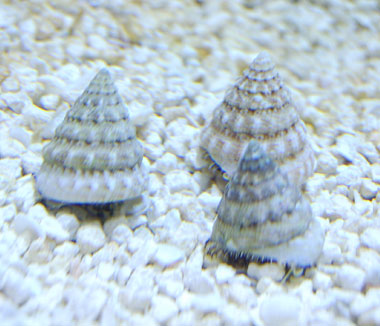
The hit parade for algae controlling invertebrates includes snails, crabs and sea slugs. For snails, we like Astraea Snails, Nerite Snails, Margarita Snails (so long as they are not temperate ones), Trochus Snails, and Turbo Snails. For crabs, Emerald Crabs are the best algae-eating species, as they are a largely herbivorous crab (somewhat of an anomaly in the world of crabs). In terms of Sea Slugs, the Sea Hare, according to Mark Martin, director of Marine Ornamental Research at Blue Zoo Aquatics, is very popular and is pound for pound the best at algae control. Also, dont overlook lettuce slugs; they do a good job with algae control.
Grazing Snail Confusion
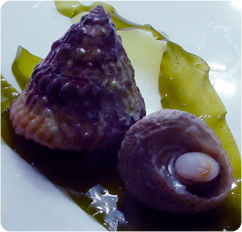
Often aquarists purchase a pre-selected clean-up crew and add that to their aquarium, never taking the time to properly identify the individual animals. As a result, there is a lot of confusion, particularly when it comes to snails and especially the Trochus Snails and Turbo Snails. Most of the snails we keep in our aquaria to control algae are from four families of gastropods:
Trochidae (Trochus Snails, Margarita Snails)
Turbinidae (Turbo Snails, Astraea Snails)
Neritidae (Nerite Snails)
Cerithiidae (Cerith Snails)
The two most common families are Trochidae and Turbinidae, commonly called turban or top snails. With many, many similar looking species (in the hundreds) within these two families, it is easy to become confused. Lets try to add some clarity.
All of these snails have a characteristic conical shell (looking something like a turban or a top), which is usually smooth or has rounded edges. The common Astraea Snail (from the Family Turbinidae) is one exception with its star-like (hence the name Astraea) arms. To tell the difference between a snail belonging to the Trochidae family and the Turbinidae family, simply look at the operculum (this is the trap door the snail uses to close the shells opening). Snails from the family Trochidae have a brown and somewhat horny operculum, while snails from the family Turbinidae have a white operculum.
Regardless of whether a snail belongs to the Trochidae or Turbinidae family, it is an algae grazer and, if given enough healthy microalgae growth, will do well in the saltwater aquarium. It should be noted, of course, that these snails will not take care of all algae. With the exception of ceriths, the grazing snails discussed here feed exclusively on diatoms, dinoflagellates and microalgae. Most are not equipped to eat macroalgae (although they can feed on the macroalgae sporelings).
Adding grazing snails to your aquarium for algae control is heartily recommended as long as you dont add too many, too fast (often resulting in starvation), you acclimate them properly, and you keep your water parameters stable. Feel free to use this well-tested clean-up crew chart to plan how many invertebrates to add to your system for algae control.
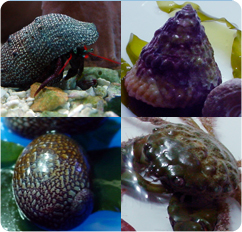
Sand Sifting
If you have a sand bed, chances are you will want some invertebrates that will constantly shift and stir the sand. Nassarius Snails, Sand Sifting Starfish and Tiger Tail Cucumbers are all excellent sand sifting invertebrates, and all can make excellent additions to the marine aquarium. Lets briefly take a look at each.
Nassarius Snail
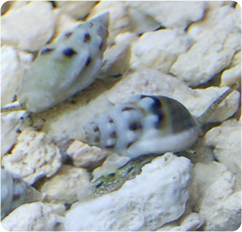
The Nassarius Snail is a gastropod from the Family Nassariidae. They make excellent scavengers, emerging from the sand when food is added to the aquarium and then descending back into the sand bed with only their snorkel sticking out. This process of emerging and burying themselves in the sand helps to keep the sand stirred, as does their movement over the substrate in pursuit of food. They grow to about an inch in length, and they wont harm live animals. If you have a sand bed, Nassarius Snails are highly recommended.
Sand Sifting Starfish

Sand Sifting Starfish generally come from one of two genera from the Class Asteroidea (starfishes). Astropecten polyacanthus are more common, and can be excellent sand bed cleaners, although some reef enthusiasts choose not to have them, as they can strip the sand of all edible material (even the good stuff). It is also not wise to place Sand Sifting Starfish in a small aquarium or a new aquarium, where they will likely starve. You can readily identify an Astropecten spp. by the comb-like appearance on the fringes of each of its five arms.
Tiger Tail Sea Cucumber

Sea cucumbers are echinodermsrelated to starfish, sea urchins and brittle stars. Taxonomically-speaking sea cucumbers are part of the subphyla Eleutherozoa or the motile echinoderms (as opposed to the sessile echinoderms like crinoids). The phylum nameEchinodermatameans something like spiny skin, but the sea cucumbers so-called spines are really more like warts.
The most commonly available sea cucumbers are from the genus Holothuria. The Pink and Black Sea Cucumber (Holothuria edulis) is from the Indo-Pacific and grows in captivity to about eight inches. The Indo-Pacific Tigertail Sea Cucumber, which is also known as the Sand Sifting Cucumber, the Lollyfish or the Light Spotted Sea Cucumber (Halathuria hilla) seldom grows to a foot in length.
Despite what you may have heard, the Tiger Tail Sea Cucumber is a great reef inhabitant in our opinion. This is an herbivore that literally vacuums up the sand, consumes bacteria and microalgae, and then passes it as sparkling clean sand. The reason many people fear sea cucumbers is that, when threatened, they can eviscerate themselves and release a toxins called holothurin. Eviscerations are not always accompanied by chemical discharge, but when they are, they can have dire consequences for other livestock if the system is too small (less than 50 gallons). In short, we think sea cucumbers are great, and thats why we include them with our pre-selected clean-up crew packages for all tanks over 50 gallons. IF you decide to keep a sea cucumber, keep the following in mind:
Only keep sea cucumbers in a tank with a sand bed.
Only have one sea cucumber for every 50 to 75 gallons of aquarium water.
Keep the water quality high.
Make sure all powerheads and intakes are covered.
Watch out for species that may nip and harass sea cucumbers (e.g. triggerfish, Wrasses, Butterfly fish, and large hermit crabs).
Consult the following chart for guidelines how many of each animal to consider adding to your system for sand sifting.
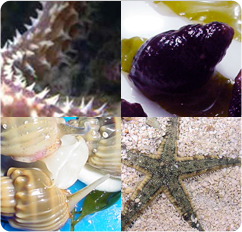
Detritus Control
What is detritus anyway? Detritus, generally speaking, is not a good thinghence the need for janitorial invertebrates to deal with it. First off, there are no true detritus eating invertebrates in the wild. The animals aquarists think of as detritivores are really omnivores that are extremely opportunistic. In other words, they will eat anything including left over food, some amount of waste, dead animals, sheddings from animals, and a range of other, as the butcher puts it, bits and pieces.
For detritus control, a few snails such as Bumble Bee Snails, Nassarius Snails, Cerith Snails, and Tonga Fighting Conch should be employed, but a crew of small, reef-compatible hermit crabs is, in our opinion, invaluable. In particular, Blue Leg Reef Hermit Crabs and Scarlet Reef Hermit Crabs should be seriously considered for detritus control, as should Sally Lightfoot Crabs in aquaria of 50 gallons or larger. Be sure to check the chart below for recommendations on numbers of animals to add for detritus control.
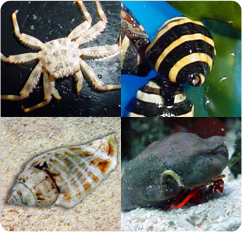
Fish Cleaning
There are several invertebrates that perform important maintenance in the reef aquarium, but, instead of cleaning your sand bed, aquarium walls or rock, they actually tend to your livestock. Cleaner shrimp are the obvious invertebrate cleaners, but there are a few others that you may want to consider.
Cleaner Shrimp
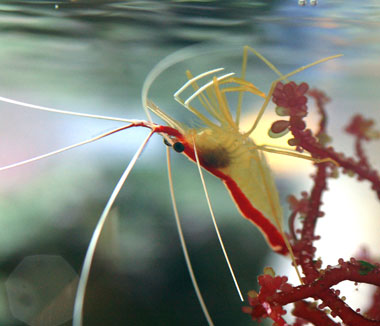
The most obvious choices for cleaner shrimp come from the family Hippolytidae and include the genera of Lysmata, Saron, Thor, and Tozeuma with Lysmata amboinensis being the cleaner shrimp in most aquarists minds. These invertebrates will (to greater and lesser degrees) pick parasites and other debris from your fishes. L. amboinensis is an Indo-Pacific shrimp commonly called the White-Striped Cleaner Shrimp, the Ambon Shrimp or, simply, the Cleaner Shrimp. This is the probably the best cleaner shrimp commonly available to the hobbyist, as it can be kept in groups and, generally speaking, takes its cleaner responsibilities seriously. Take the time to drip acclimate appropriately and provide them with plenty of hiding spots (particularly important when they molt). In addition to cleaning your fishes, these shrimp will also feed on just about any foodstuff you put in the aquarium.
While generally tiny and semi-transparent, dont overlook cleaner shrimp from the Family Palaemonidae, otherwise known as Anemone Shrimp and Rock Shrimp. These shrimp will host in a variety of corals and anemones, and some will readily set-up cleaning stations. Some of the best species to consider include ones from the genus Periclimenes, such as:
Pacific Clown Anemone Shrimp Periclimenes brevicarpalis
Holthuis' Cleaner Shrimp Periclimenes holthuisi
Emperor Shrimp Periclimenes imperator
Glass Anemone Shrimp Periclimenes brevicarpalis
Cleaner Crabs
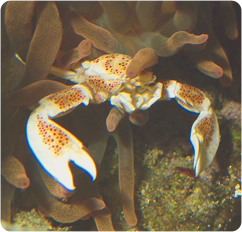
There are a variety of crabs that live commensally with sessile invertebrates, although there is some debate regarding if they are, at times, more parasitic or even helpful. Regardless, you might look at crabs form the genus Neopetrolisthes (e.g. Porcelain Anemone Crabs), as well as ones from the Family Trapeziidae (e.g. Coral Crabs such as Trapezia flavopunctata commonly called the Yellow-Spotted Guard Crab).
Conclusion
That brings us to the end of part one in this series about how to choose an invertebrate for your saltwater aquarium. In this part, we dealt with janitorial invertebrates that perform a variety of invaluable functions in the marine aquarium. In the next part in the series, we will be looking at invertebrates that we keep primarily for their beauty. We will continue to limit our discussion to motile invertebrates (no corals), and we will take a look at some of the most stunning marine invertebrates in terms of selection and husbandry.
|